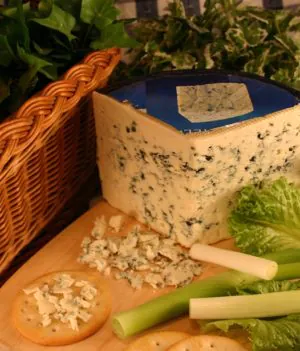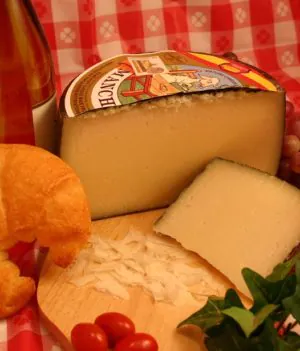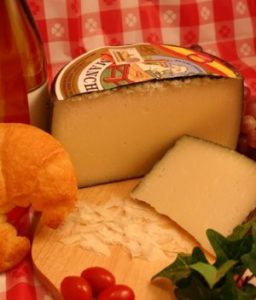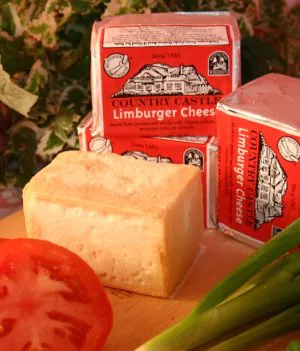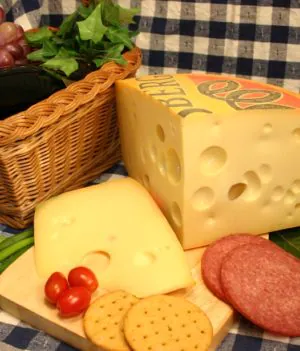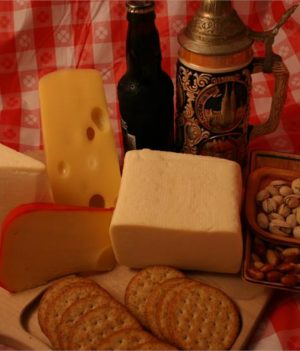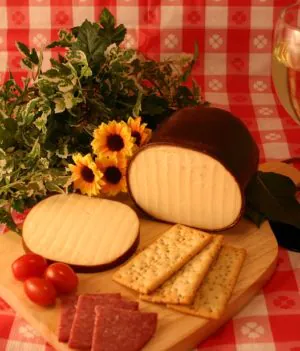Blog
Why do we eat moldy cheese?

It’s a question that a lot of cheese lovers will hear: why do we eat moldy cheese?
There are some molds that are safe to eat. These are used to make cheeses such as Brie, Blue Cheese, and Camembert.
For Blue Cheese, Penicillium cultures added creating dark blue or blue-grey veins throughout the cheese. These are safe to eat because they do not produce the toxins that could be harmful to us.
The way that Blue Cheese is aged creates a level of acidity, salinity, moisture, density, temperature, and oxygen flow that cannot create dangerous molds.
In fact, our bodies can use the variety of different properties found in blue cheese to contribute to our healthy digestion.
Blue molds cause a breakdown of proteins in cheese known as proteolysis which creates a very creamy taste and texture. It also breaks down the fats, known as lipolysis, which gives blue cheese the tangy, sharp flavors that people love.
One of the reasons that people love moldy cheese is because these cheese often contain much more salt than other cheeses. Combined with the blue veins and whole milk, this creates a flavor that makes you want to eat more and more.
Blue cheese was discovered almost by accident. Cheeses in Europe were aged in high moisture caves which are also ideal environments to produce mold. Gorgonzola dates back to around 879 AD and Roquefort was invented in 1070. Today, all Roquefort eaten around the world is still made in the small French village where it was invented.
If you love rich, tannic red wines such as Cabernet Sauvignon or Pinot Noir then you are likely to enjoy moldy cheese with it as you like strong flavors. Sometimes, we develop a stronger love for blue cheeses as we age because our taste buds reduce in strength. This means that flavors that we might not have enjoyed in childhood or younger years can become some of our favorite foods. People will often experience this with other strong flavored foods such as olives.
If you are looking to try more blue cheese, enjoy it with crackers or melted into dishes, to begin with. You’ll be able to build up to eating more of it over time. It’s also delicious with Port and Scotch if you are having a cheeseboard after dinner.
So, next time you are asked why you eat moldy cheese, or whether it’s safe to eat, you’ll know how to answer!
Do you like to eat moldy cheese? Let us know how you like to eat it in the comments!
Manchego Cheese: Everything you Need to Know
What is Manchego Cheese?
Manchego is a sheep’s milk cheese from Spain. The shape of Manchego cheese is very characteristic and defined. It has an intense taste and crumbly texture which makes it perfect for eating alone. It has a rich golden color and small holes.
It is traditionally made with grass molds so it has a very distinctive zigzag pattern on the cheese. It appears as a herringbone pattern n the rind, which is inedible.
How is Manchego cheese aged?
The rich, semi-firm product is aged in natural caves for two to six months, giving it a zest and exuberant flavor. It is always aged for a minimum of two months.
There are significant changes in the flavor over time and sometimes in Spain, you will see it served in a variety of ages.
History of Manchego Cheese
Manchego cheese is made in the La Mancha region of Spain. It has a long historical and literary tradition, as it was mentioned by Cervantes in the legendary “Don Quixote of La Mancha”.
It is made from the whole milk of the Manchega sheep, which are only bred in the La Mancha region. Archaeological remains show that a cheese like Manchego may have been made as far back as the Bronze Age.
What does it taste like?
It has a caramel, nutty flavor with some acidity. The longer it is aged, the more the flavor resembles butterscotch.
How should I eat it?
Manchego is a great cheese for eating on its own or as part of a cheese board. It pairs beautifully with fruits such as figs and plums. It’s also delicious with fruity chutneys.
Membrillo, a quince paste, is often served with Manchego Cheese as the textures and flavors create a great contrast.
It’s also great with savory flavors such as olives, sundried tomatoes, and crusty bread.
It also grills well so it can be delicious in a grilled cheese or grated over baked pasta dishes instead of parmesan. We love it in quesadillas with some spicy chorizo.
If you are serving a tapas dinner, a block of manchego is a great addition to the table. Add some bread and a bottle of red wine – you’ll keep all your guests happy.
What should I drink with Manchego Cheese?
It pairs well with a robust red wine such as Rioja or Tempranillo. It is also delicious with a glass of dry sherry.
The aromatic intensity of a Manzanilla wine also makes it an excellent foil for Manchego cheese.
Have you tried Manchego? How do you like to eat it? Let us know in the comments!
Limburger Cheese: Everything You Need to Know
We’re continuing our mission to show you all the cheese that we can by telling you all about Limburger Cheese.

What is Limburger Cheese?
Limburger is rated as one of the stinkiest cheeses in the world! It is a spreadable cheese with an almost bitter flavor. A rind washed cheese, it has a distinct brown-colored rind with semi-soft, ivory cheese inside.
How does Limburger Cheese mature?
The bacteria Brevibacterium linens causes the odor and the maturing process which creates Limburger. When it is young it has a firm, crumbly texture with a salty flavor, like feta. At six weeks, the edges soften but the center stays firm. By two months it is almost all smooth and creamy and by three months it develops its intense smell and flavor.
History of Limburger Cheese
Limburger originated in the historical Duchy of Limburg, which is now divided between modern-day Netherlands, Belgium, and Germany. However, most Limburger today comes from Germany. Only one company in the United States still makes it, the Chalet Cheese Cooperative of Monroe, Wisconsin. We’re proud to source our Limburger Cheese from Wisconsin.
What does it taste like?
It can be quite mild but it also has a distinct grassy and mushroom taste. The aftertaste has a tang to it.
How should I eat it?
One of the most traditional ways to eat Limburger Cheese is the Limburger sandwich. The cheese is spread thickly on firm rye bread with a large, thick slice of onion. The sandwich is typically served with strong black coffee or lager beer. Chunks or slices of the cheese up to 1.5 cm thick may be cut off the block and placed in the sandwich. This still remains very popular among the descendants of German immigrants residing in the Midwest of America. In Wisconsin, you can still find the Limburger sandwich on menus, accompanied with brown mustard.
It can also be used to make an extra pungent mac and cheese. Simply stir some into the sauce and top with a rye breadcrumb for some extra crunch.
We really recommend trying the Limburger sandwich for the true experience. If you love it then you can add it wherever you might usually enjoy cheese: a grilled cheese, grated on top of dishes or over fries. It may not work so well on a cheeseboard because the aroma is likely to affect your enjoyment of the other cheeses.
What should I drink with Limburger Cheese?
Limburger Cheese is too overpowering to serve with wine. It’s usually served with lager or strong black coffee. A Belgian style beer would also pair well with it.
Have you tried Limburger Cheese? Have you braved its pungent odour? Will you be trying the sandwich? Let us know in the comments!
Pepper Jack Cheese: Everything You Need to Know
What is Pepper Jack Cheese?
Pepper Jack Cheese is a cow’s milk cheese that blends the creamy, buttery flavor of Monterey Jack cheese with the intensity of spicy peppers. Jalapeños, serrano peppers, and habañero peppers are all used to create heat. As the cheese ages, the peppery flavor intensifies. Some older pepper jacks can taste quite zesty, but generally, the cheese is only aged for a few months. It will take on a creamy color and semi-firm textures.
How is Pepper Jack Cheese made?
Monterey Jack Cheese was made by the Mexican Franciscan friars of Monterey, California, in the 19th century. Then David Jack, a California businessman, decided that the market for the cheese could be developed. He produced the mild, white cheese that we now call Monterey Jack. Later, producers began to add small pieces of spicy peppers to the curds of their Jack cheese, creating Pepper Jack Cheese.
How should I eat Pepper Jack Cheese?
Pepper Jack Cheese melts very well. This makes it great for quesadillas, hot sandwiches, and nachos. Try adding it to Mexican food as these flavors pair well together.
The moist texture also makes it suitable for grating over dishes. It goes especially well with barbecued meats such as beef, and it can be used on burgers, steaks, and various broiled dishes. You could also serve cubes or slices as part of a cheese platter. Try it with melons, grapes, pickled vegetables, and olives for contrast and great texture. Slice it into sandwiches with bologna for a picnic.
Try it in mac and cheese with fresh slices of jalapeño to create a spicy side dish or comforting meal. Stuff it into a chicken breast and wrap it with bacon for a flavor explosion. You can even put a cube into the middle of a homemade burger so that you get oozing melted cheese when you bite into it.
What should I drink Pepper Jack Cheese with?
Pepper Jack Cheese goes best with slightly sweet white wines like Chardonnay, Riesling, or dessert wines. These complement the spicy and creamy nature of the cheeses. It’s also great with a light beer. You’re looking for a beer that isn’t too hoppy or powerful in flavor, as this can bring out the bitterness of the spice. Instead, go for a light lager.
Spicy cheeses
If you already love Pepper Jack Cheese and you’re looking to get even more spicy cheese into your life then we stock a huge range in the cheese shop and online. Check out our Carolina Reaper Cheese, Scorpion Cheddar, Ghost Pepper Cheese, Smoked Habanero Cheddar, Super Hot Pepper Cheese, Hot Pepper Cheese, Smoked Hot Pepper Cheese, Smoked Horseradish Cheese, Yogurt Cheese with Jalapenos, Hot Pepper Cheese Curds, and Buffalo Wing Cheese Curds.
Some of these are super hot whilst others combine chili spice with creamy cheese flavors. The smoked cheeses are great for BBQ dishes. Try them all to find your favorites!
How do you like to eat Pepper Jack Cheese? Let us know in the comments!
Buy Pepper Jack Cheese @ $ 5.99 per Lb : Click Here
Jarlsberg Cheese: Everything You Need to Know
What is Jarlsberg Cheese?
Jarlsberg cheese is from Norway and is known for its distinctive sweet and nutty taste. It has large, round holes and a very buttery texture. It is almost sweet whilst having a clean flavor.
It has become popular around the world, with huge sales in both the United States and the United Kingdom.
History of Jarlsberg Cheese
Cheese with holes has been made in Laurvig and Jarlsberg, in the south of Norway, since the 1830s. In 1956, Professor Ole M. Ystgaard from the Agricultural University of Norway began doing research on these cheese recipes, recognizing the value of this type of cheese. During his research he developed a semi-hard, medium-fat cheese with large holes, successfully combining the cheese-making traditions with modern technologies. The new cheese was named Jarlsberg Cheese after the county where the earlier version had been made.
The holes are the result of cheese cultures added according to a secret recipe that is closely guarded. The cultures will create carbon dioxide, making bubbles in the cheese that eventually leave holes.
How to eat it
This versatile cheese is great on a cheeseboard but can also be eaten in a variety of hot and cold dishes.
It’s truly awesome melted onto a burger, perfect for barbecue season. It makes an excellent fondue, ready for dipping in bread, apple slices, and celery sticks. Add it to Mac and Cheese for extra nutty, cheesy flavor. Try it in paninis with ham or mushrooms (or both!). It’s also a great cheese for grating onto any baked savory dish to add a cheesy topping.
For true simplicity, slice it thinly and make a sandwich with your favorite bread. This is one of the best ways to enjoy the flavor of the cheese without distractions.
What to drink with Jarlsberg®Cheese
To complement Jarlsberg Cheese’s sweet, nutty flavor and open texture, choose light, fresh white wines rather than reds. Dry or semi-dry whites made from Chardonnay or Riesling grapes are your best bets. Think Chablis, White Burgundy, or a light, spicy Gewürztraminer.
Jarlsberg Cheese also works well with most beers. For those with a taste for stronger drink, it combines perfectly with Aquavit, a traditional Scandinavian liquor distilled with aromatic botanicals like caraway, cumin, cardamom, orange peel, aniseed, and fennel. This creates an experience you won’t soon forget.
Imported Cheeses
Jarlsberg Cheese is one of our newer imports and we are proud to stock it. We have been adding to our selection and will continue to add more in the future. Some of our other imported cheeses include Canadian Cheddar, Chevre, Danish Bleu Cheese, Gouda, Gruyere, Manchego, Mozzarella, Parmesan, Provolone, Raclette, and Pecorino Romano.
Have you tried Jarlsberg Cheese? Let us know in the comments.
Get ready for the 4th July!

4th July is here again! We’ve put together a few tips for you to help prepare for tomorrow’s festivities.
Food
Food is, of course, one of the most important parts of any 4th July celebration!
Take a look at our barbecue checklist if you’re going to be grilling with your family. If you’re holding more of a formal dinner, read all about how to create a beautiful table setting. We know you might be serving beer, so if you’re looking for some cheese to enjoy we recommend our beer collection. It contains Brick Cheese, Gouda, Gruyere and Ohio Premium Swiss Cheese, so you’ll have a great selection to share. Add a few pickles and some ham and you’ve got a board that will keep even the hungriest guests happy.
Make it easy with a great selection of salads, grilled meats, and cheeses. Stock up on snacks to keep energy levels high and you’ll be partying into the night.
Drinks
You’ll need something to wash down all the fabulous. Check out our list of perfect summer drinks to get inspiration. It’s the perfect time to make a pitcher of something refreshing and allow everyone to help themselves. Remember that everyone needs a chance to celebrate so you don’t want to be stuck in the kitchen making food and mixing drinks!
For true simplicity, fill a cooler with beer and soft drinks and you won’t even have to worry about preparing anything.
Festivities
It’s time to set off some fireworks! Stock up and put on a real display for your family and friends. Make sure to stay safe and take all necessary precautions. You’re sure to be able to find local parties if you can’t host at home.
We love to play some games when we get together as a family. Whether it’s running around with super soakers, playing bingo or taking part in a scavenger hunt, creating a simple activity can elevate your party to the next level.
We want to wish all of our customers a happy and healthy Independence Day. We hope it means time spent with family or friends, but if it doesn’t we hope that you get to take a moment for your own personal celebration.
Let us know how you’ll be celebrating this 4th July in the comments.
Blue Cheese: Everything You Need to Know
What is blue cheese?
Blue Cheese is a generic term for cheeses that have had Penicillium cultures added creating dark blue or blue-grey veins throughout the cheese. It can be made from cow, sheep, or goat’s milk and is typically aged in a temperature and moisture-controlled environment like a cave.
How was blue cheese discovered?
Blue Cheese is said to have been discovered by accident. Cheeses in Europe were aged in high moisture caves which are also an ideal environment to produce mold. Gorgonzola dates back to around 879 AD and Roquefort was invented in 1070. Subsequent Blue cheeses were invented to fill the demand for Roquefort like cheeses. We prefer Danish blue, as it is more moderate in its sharpness and more creamy.
What does it taste like?
The characteristic flavor of blue cheese is usually sharp and salty, but levels of sharpness vary by region. It can be eaten by itself or crumbled or melted over foods. We know that blue cheese can divide opinion, so we’ve put together a list of tips that will help you to appreciate it!
Serve it at the right temperature
The unique flavor of blue cheese is best appreciated at room temperature to allow the flavors and textures to be enhanced. This goes for most cheeses: they should not be served straight from the fridge if you want to truly enjoy them.
Serve it with the right drinks pairing
Blue cheeses are strong, rustic-flavored cheeses and go best with similarly strong, flavored foods and drinks, and with tannic red wines such as Cabernet Sauvignon, Pinot Noir, Syrah, Zinfandel, and even Port. For beer lovers, the cheese compliments porters and stouts perfectly. It also pairs very well with Scotch, which is why we offer it with our Scotch collection.
Serve it with the right foods
Just as blue cheese deserves strong flavors from drinks, it needs them from food too. One classic combination is cheese with fruit. Pears, figs, and apples all stand up well to the flavor as they each have a sweetness that cuts through the saltiness of the cheese. The earthy quality of mushrooms brings out the same flavors in the cheese and the crunch of celery will contrast with the creaminess of any blue cheese.
It’s just as important to consider texture as well as flavor. Find crunchy foods to pair with the soft texture of the cheese and you’ll find it really stands out.
Start small
If you’re not yet a blue cheese fan, start by trying small pieces as part of a cheeseboard. You’ll gradually be able to move up to crumbling a little into soup or over pasta. In no time you’ll be asking for it on pizza and enjoying it with a glass of port! Let it surprise you. Sometimes we think we might not like something but in the right combination it is our new favorite dish.
Do you think you could become a blue cheese lover? We really do recommend trying our Danish Blue – it’s converted many a customer in the past!
Let us know your favorite blue cheese pairings in the comments!
What is Yogurt Cheese?
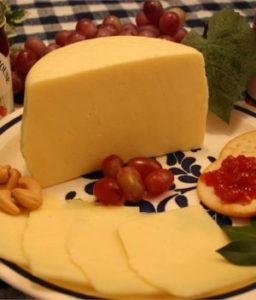
Yogurt Cheese is a lower calorie and lower fat alternatives to traditional dairy cheese. It is the creamy white cheese left over when liquid whey drains from the fresh yogurt. This is all natural and a great way to supplement your diet with calcium and protein, without adding fat. It’s low in sodium and lactose (milk sugar) but still tastes super creamy and rich!
We know that choosing healthy options is really important to many of our customers which is why we have chosen to shine the spotlight on our yogurt cheese today.
A range of flavors
We offer a Plain Yogurt Cheese, Garlic and Herb, Jalapeno, and Vegetable.
Ways to eat it
- On a bagel
We love yogurt cheese spread onto a bagel instead of cream cheese. This is a great, healthy breakfast or lunch option even when you’re on the go. We especially love our flavoured cheeses. Jalapeno will give you a great spicy kick.
- With peanut butter
Yogurt cheese can be used to lengthen products that might have a high fat content. Mix 1 tablespoon of peanut butter with 1- 2 tablespoons of cheese. The yogurt cheese takes on the flavor of the peanut butter but has lower fat.
- With mayonnaise
Just as with peanut butter, this can be used to expand your mayonnaise as it will take on the flavor. Mix 1 tablespoon mayonnaise with 1- 2 tablespoons cheese, then eat it with salad or even chips.
- On a Baked Potato
Yogurt Cheese is delicious on a baked potato, especially our flavoured varieties. You can even mix it with sour cream, chives or herbs for a traditional flavor.
- As an alternative to whipped cream
Mix ¼ teaspoon of cinnamon or ½ teaspoon vanilla extract into 2 tablespoons of yogurt cheese for a whipped cream alternative. Great served with berries or an apple tart.
- With Salmon
Yogurt Cheese makes a great accompaniment to fish instead of a fatty, creamy sauce.
- In a soup
Add protein to your soup without the calories by adding a couple of spoonfuls of yogurt cheese.
- As an alternative to frosting
Mix ½ cup confectioners’ sugar, ½ teaspoon vanilla extract and 1 cup cheese. This is great on cakes. Make sure that you chill it before spreading so that it does not melt on the cake.
- In pasta
A great way to make a creamy sauce for pasta that has plenty of flavor. Use our garlic and herb flavor and you won’t even need to add anything else. A quick, healthy dinner in minutes!
- As a chocolate mousse
Mix 1 packet of low-calorie chocolate drink mix with 1 cup of cheese. Chill in the fridge before serving.
Now you know everything you need to know about yogurt cheese! How will you try it? Let us know in the comments!
Barbecue season is here: grab our checklist

Barbecue season is upon us, so it’s time to prepare! We often find that at the beginning of the summer it’s a bit of a scramble to get everything you need together for a barbecue.
Let us help you out with our quick checklist.
- Meat!
This is the one thing you’re not likely to forget. Try to get the best quality meat that you can. If you haven’t tried making homemade burgers before, give it a go. Otherwise, you can’t go wrong with burgers and hot dogs from the butcher. For something really special, grab some steaks. If you want to inject plenty of flavor, then chicken wings and thighs take on marinades really well.
- Veggies
It’s great to get some vegetables on your plate and this will mean you have something to serve vegetarian guests. Eggplant, zucchini and squash all cook well on the barbecue. Large mushrooms and tomatoes on the vine can work well too. You can always parcel up veggies in foil and then place them on the barbecue if they might slip through.
- Bread
Hot dog and burger buns are essential for carrying all of that delicious meat. You might want to bake a quick loaf to serve with cheeses and salads, but no-one will turn down a store-bought sesame bun!
- Salads
A simple green salad will go a long way as it can be eaten on the side or even in your burger. A caprese is a great salad for serving at barbecues as the flavors of tomato and mozzarella go so well together and will develop throughout the day. Whip up a potato salad and you’ve got a perfect selection to serve to your guests.
Don’t forget to add salad dressings to the table. We recommend letting your guests dress their own salad so that they can pick their favorite dressings and the leaves will stay crisp.
- The extras!
A barbecue is really made special because of all the extra touches.
Cheese is essential. The classics are a slice of Cheddar or American Cheese, but Blue Cheese and Swiss are also delicious melted onto burgers. You could also put cheese onto the barbecue. Halloumi is a particularly good option as it won’t melt and has a lovely, salty taste. Definitely stock up or even have a go at making your own.
Make sure you’re stocked up on sauces such as ketchup, mayonnaise, mustard and, of course, barbecue.
- Drinks
Beer is the classic, but there are plenty of refreshing summer drinks. Mix up a jug of something cool for designated drivers and pop a bottle of champagne in the fridge if it’s a special occasion.
Has this inspired you to get the grill going? Let us know in the comments!
Smoked Cheese: Everything you need to know
Are you a cheese lover? Have you ever tried smoked cheese?
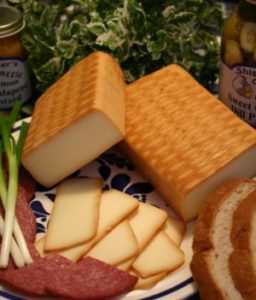
We stock a huge range here at Shisler’s Cheese House but we know that some customers don’t pick it up because they’re not sure about how it’s made or how to use it. That’s where this blog post comes in. We’re going to tell you everything you need to know about smoked cheese and show you some great uses for it so that you can add this delicious treat to your table.
A huge range of smoked cheese
We currently offer Smoked Baby Swiss, Smoked Bacon Cheese, Smoked Cheddar, Smoked Gouda, Smoked Habanero Cheddar, Smoked Horseradish Cheese, Smoked Hot Pepper Cheese, Smoked Mozzarella, Smoked Provolone, and Smoked Swiss Cheese.
That’s 10 smoked cheeses to choose from! We recommend that if you haven’t tried it before, start with a simple hard cheese such as the Smoked Cheddar or Smoked Gouda.
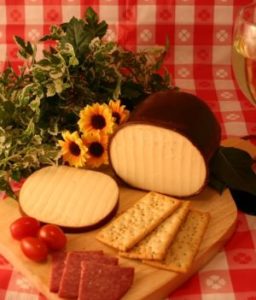
How is cheese smoked?
There are several ways to smoke cheese, but the main ones are the cold or hot smoke processes. The cold smoke method involves smoking chunks of cheese in a smoker for a few hours at a time with a tray of ice under the cheese. This allows the smoke to infuse into the cheese without it getting too hot and melting. Some smokers will keep the heat source separate to the cheese so that there is no need for the ice.
Smoked cheeses are usually aged for a brief period to allow the smokiness to mellow. The type of wood used will affect the flavor of the cheese. Common types of wood used include apple, oak, hickory, and chestnut. Our Smoked Cheddar is slowly smoked over a hickory fire to give it a deeply smoky flavor. So is our Smoked Horseradish Cheese which has a kick from the horseradish root and our Smoked Hot Pepper Cheese which is also really spicy. Our Smoked Mozzarella is smoked using both hickory and cherry wood smoke.

How should I eat smoked cheese?
There are so many ways to enjoy this but we are going to share just a few with you to give you inspiration today.
- On a cheeseboard
Add another dimension and extra flavor to your cheeseboard with smoked cheeses. They’re also great if you’re building a board around different textures of cheese. These are hard to semi-soft cheeses so you have a good range to choose from. Smoked cheese will surprise your guests if they haven’t tried it before!
- In a sandwich
Thin slices of smoked cheese alongside a good quality ham makes for a very special sandwich indeed. A sweet relish will offset the smokiness if you need some balance.
- On tacos
Grate some smoked cheese over your tacos for an authentic, smoky flavor.
- With fruit
Tart apples or white grapes are the perfect accompaniment to smoked cheese as the flavors marry really well.
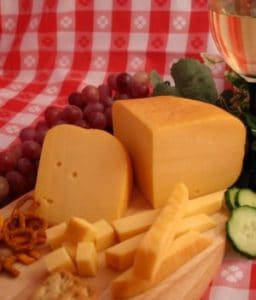
We hope you learned something about smoked cheese today! Have you tried it? Let us know in the comments!

